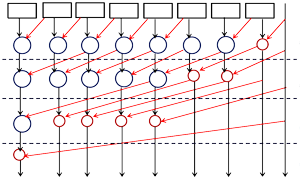Efficient fused MAC unit using multi-operand parallel prefix adder
DOI:
https://doi.org/10.3103/S0735272722040057Abstract
In this brief, various multi-operand parallel prefix adders are designed and they are implemented in fused multiply-accumulate (MAC) unit. A multi-operand adder is the fascinating technique in contrast with a network of 2-operand adders in many arithmetic applications. Also, the parallel prefix adder is one of the high speed adders. Thus, multi-operand adders are designed using various parallel prefix graphs which are used for implementing fused MAC unit. Initially, the parallel prefix adders are structured and analyzed. Secondly, the designed parallel prefix adders are restructured for multi-operand operations. Finally, MAC unit is implemented using various multi-operand adders. The proposed multi-operand parallel prefix adders are designed in Xilinx Kintex 7 FPGA. In contrast with existing one, the Ladner Fischer multi-operand adder provides optimum results based on the power consumption, area and delay. In accordance with the results attained from Kintex 7 FPGA, the Ladner Fischer multi-operand adder outperforms based on power consumption by 38.06%, path delay by 17.54% and number of LUTs by 26.55% against the existing one. Subsequently, the Fused MAC unit designed using Ladner Fischer multi-operand adder provides the reduction in power consumption by 39.95%, path delay by 16.83% and number of LUTs by 13.73% in contrast with the classical MAC unit.
References
S. Singh, R. Waxman, “Multiple operand addition and multiplication,” IEEE Trans. Comput., vol. C–22, no. 2, pp. 113–120, 1973, doi: https://doi.org/10.1109/T-C.1973.223670.
L. Tu, Y. Yuan, K. Huang, X. Zhang, D. Chen, Z. Wang, “Improved synthesis of compressor trees in high-level synthesis for modern FPGAs,” IEEE Trans. Comput. Des. Integr. Circuits Syst., vol. 37, no. 12, pp. 3206–3210, 2018, doi: https://doi.org/10.1109/TCAD.2018.2801241.
K. R. Gavali, N. Choudhary, S. Mishra, S. Dubey, “A parallel pipelined adder suitable for FPGA implementation,” in 2018 International Conference on Smart City and Emerging Technology (ICSCET), 2018, pp. 1–4, doi: https://doi.org/10.1109/ICSCET.2018.8537358.
S. Kannappan, S. Aruna Mastani, “A novel multi-operand adder design using multiplexers,” in 2017 IEEE International Conference on Computational Intelligence and Computing Research (ICCIC), 2017, pp. 1–4, doi: https://doi.org/10.1109/ICCIC.2017.8524157.
R. D. Kenney, M. J. Schulte, “High-speed multioperand decimal adders,” IEEE Trans. Comput., vol. 54, no. 8, pp. 953–963, 2005, doi: https://doi.org/10.1109/TC.2005.129.
J. Villalba, J. Hormigo, J. M. Prades, E. L. Zapata, “On-line multioperand addition based on on-line full adders,” in 2005 IEEE International Conference on Application-Specific Systems, Architecture Processors (ASAP’05), 2005, pp. 322–327, doi: https://doi.org/10.1109/ASAP.2005.50.
D. V. Morozov, M. M. Pilipko, “A circuit implementation of a single-bit CMOS adder,” Russ. Microelectron., vol. 42, no. 2, pp. 113–118, 2013, doi: https://doi.org/10.1134/S106373971302008X.
M. M. Pilipko, D. V. Morozov, “Comparative analysis of CMOS adders circuits based on 10 transistors,” Radioelectron. Commun. Syst., vol. 57, no. 9, pp. 418–427, 2014, doi: https://doi.org/10.3103/S0735272714090040.
J. Hormigo, J. Villalba, E. L. Zapata, “Multioperand redundant adders on FPGAs,” IEEE Trans. Comput., vol. 62, no. 10, pp. 2013–2025, 2013, doi: https://doi.org/10.1109/TC.2012.168.
S. D. Thabah, M. Sonowal, P. Saha, “Experimental studies on multi-operand adders,” Int. J. Smart Sens. Intell. Syst., vol. 10, no. 2, pp. 1–14, 2017, doi: https://doi.org/10.21307/ijssis-2017-214.
B. Khurshid, R. N. Mir, “High efficiency generalized parallel counters for Xilinx FPGAs,” in 2015 IEEE 22nd International Conference on High Performance Computing (HiPC), 2015, pp. 40–46, doi: https://doi.org/10.1109/HiPC.2015.41.
M. Kumm, J. Kappauf, “Advanced compressor tree synthesis for FPGAs,” IEEE Trans. Comput., vol. 67, no. 8, pp. 1078–1091, 2018, doi: https://doi.org/10.1109/TC.2018.2795611.
S. Akash, M. Ajeeth, N. Radha, “An efficient implementation of FIR filter using high speed adders for signal processing applications,” in 2020 Second International Conference on Inventive Research in Computing Applications (ICIRCA), 2020, pp. 1047–1051, doi: https://doi.org/10.1109/ICIRCA48905.2020.9183114.
A. Abinaya, M. Maheswari, A. S. Alqahtani, “Heuristic analysis of CIC filter design for next-generation wireless applications,” Arab. J. Sci. Eng., vol. 46, no. 2, pp. 1257–1268, 2021, doi: https://doi.org/10.1007/s13369-020-05016-1.
V. Pudi, K. Sridharan, “Low complexity design of ripple carry and Brent–Kung adders in QCA,” IEEE Trans. Nanotechnol., vol. 11, no. 1, pp. 105–119, 2012, doi: https://doi.org/10.1109/TNANO.2011.2158006.
N. Varshney, G. Arya, “Design and execution of enhanced carry increment adder using Han-Carlson and Kogge-Stone adder technique : Han-Carlson and Kogge-Stone adder is used to increase speed of adder circuitry,” in 2019 3rd International conference on Electronics, Communication and Aerospace Technology (ICECA), 2019, pp. 1163–1170, doi: https://doi.org/10.1109/ICECA.2019.8822194.
A. K. Panda, R. Palisetty, K. C. Ray, “High-speed area-efficient VLSI architecture of three-operand binary adder,” IEEE Trans. Circuits Syst. I Regul. Pap., vol. 67, no. 11, pp. 3944–3953, 2020, doi: https://doi.org/10.1109/TCSI.2020.3016275.
N. Nasiri, O. Segal, M. Margala, “Modified fused multiply-accumulate chained unit,” in 2014 IEEE 57th International Midwest Symposium on Circuits and Systems (MWSCAS), 2014, pp. 889–892, doi: https://doi.org/10.1109/MWSCAS.2014.6908558.
H. Zhang, H. J. Lee, S.-B. Ko, “Efficient fixed/floating-point merged mixed-precision multiply-accumulate unit for deep learning processors,” in 2018 IEEE International Symposium on Circuits and Systems (ISCAS), 2018, pp. 1–5, doi: https://doi.org/10.1109/ISCAS.2018.8351354.
D. Esposito, D. De Caro, A. G. M. Strollo, “Variable latency speculative parallel prefix adders for unsigned and signed operands,” IEEE Trans. Circuits Syst. I Regul. Pap., vol. 63, no. 8, pp. 1200–1209, 2016, doi: https://doi.org/10.1109/TCSI.2016.2564699.


